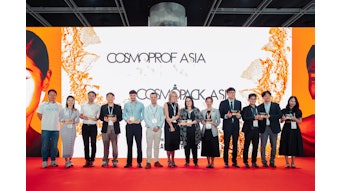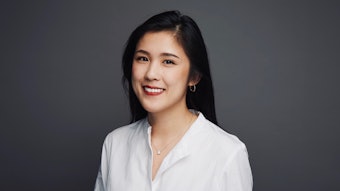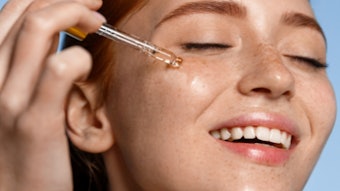The Society of Cosmetic Chemists (SCC) returned this week to New York for an on-site (and online) Scientific Meeting and Showcase. From Dec. 13-15, 2021, attendees will: reflect on the SCC's 75 years; explore advances in natural, cleaner and milder formulations; focus on diversity in beauty; seek to advance makeup and hair care; learn new findings of cannabinoids (CBDs) and the skin microbiome; take a sustainability deep dive and more.
Session A: 75 Years of Beauty and Beyond
Henry Maso Keynote Award presentation: Today's session opened with the Henry Maso Keynote Award presentation, "Historical Review of the Science of Skin," given virtually by Howard Maibach, M.D., of the University of California, San Francisco, on the "remarkable evolution" of our industry. His lecture focused on the various forces that have driven this progress, and how one can safely intuit how these societal, marketing and scientific forces will influence the near-term future of the field for both business and scientific aspects.
We [the industry] need to coordinate clear and visible information about both what's known and what's unknown."
"The last two decades have been dominated by information related to the ready availability of the computer and the internet," he wrote, in an event preview. "Yet, this explosion of information far exceeds our capacity to fully utilize same; namely the human finger and brain lacks the capacity to organize and comprehend what knowledge is being added on a daily-almost hourly basis. "Hopefully, one or more of the audiences will have the educational and work experience that will enable them to benefit from the last seven decades—and plan/execute for the coming decade and on," he adds.
During the Q&A session, Bob Lochhead, Ph.D., asked Maibach about how we as an industry deal with recent class action suits and educate the public about fact versus fiction. Maibach responded that these incidents have taken us off guard. "We need to coordinate clear and visible information about both what's known and what's unknown. That should be absolutely straightforward," said Maibach. "The FDA (U.S. Food and Drug Administration) has started to do this [informing the industry] in terms of materials getting into the skin (e.g., sunscreens)."
He added, "We have some of the most talented scientists in industry and academia. We need to coordinate them as well as take advantage of the available technologies to teach us about skin biology."
75 Years of Scientific Innovation ... and Future Predictions: Following Maibach, Randy Wickett, Ph.D., of the James L. Winkle College of Pharmacy, University of Cincinnati, presented "75 Years of Scientific Innovation and Advancements and Future Predictions," starting with a brief introduction and discussion of progress in cosmetic science education. His talk focused on the industry's greatly improved understanding of the structure of the stratum corneum (SC) and advances in skin measurement technology.
"Rapid advances in our understanding of skin structure and function and ability to measure the skin make it difficult to predict the future but at least we can speculate," he wrote, in the event preview." We can expect our understanding of the SC and of product effects on SC function to continue to evolve. We can also expect that some of the more exotic instrumental methods for skin evaluation such as Optical Coherence Tomography and multiphoton spectroscopy will become more accessible and more widely applied in cosmetic studies." He added that it also seems certain the industry's knowledge of genomics and proteomics will continue to progress leading to new ways to study, develop and improve cosmetic products.
Wickett closed with a few guesses about the future for cosmetic science:
- Expect to see the use of genetic (rtPCR) analysis to investigate the effects of treatments on specific genes. The challenge is to understand what the results really mean.
- Some of the "exotic" instruments like multiphoton spectroscopy will become more readily available to skin research labs.
- We hope to see a much wider application of imaging and other techniques for the evaluation of skin disease states.
- The use of SC biomarkers for research and claim support will continue to develop.
- There are almost certain to be more studies of the effects of air pollution on the skin. The world is not becoming less polluted.
- Maybe someday someone will figure out how someone like me can actually grow their hair back.
Milestones in understanding the health, well-being and normal functioning of skin: Following Wickett, Jason Harcup, Ph.D., global vice president for skin care R&D at Unilever, considered some of the major milestones in the fundamental management of the health, well-being and normal function of human skin; for example, the discovery of petroleum jelly's benefits to heal skin and maintain moisture. As he wrote in the event preview, "Nothing could be more fundamental to skin than water. Indeed, it is not an overstatement to say that water is really at the essential core of skin’s barrier purpose."
He added that as we will see, reinstating, maintaining and enhancing the basic hydration and moisturization of skin therefore gatekeeps against a number of highly undesirable phenomena. Looking to future areas in skin care, he noted, "There's been an explosion of AI and genomic technologies. ... And we've learned about skin microbes, which also need nutrition and water; could this be a new function for occlusives?" Finally, he pointed to the idea of "getting the skin to produce its own lipids (pro-lipids)."
Evolutions in color: Jane Hollenberg, of JCH Consulting, spoke to evolutions in color cosmetics over the past 75 years, leading off with regulatory considerations. "In the beginning, color additive regulation went to the Supreme Court," she explained, underlining how the FDA stressed that pigments, especially those in foods, should be safe for use "no matter what amount" is in a product; the industry pushed back, insisting the actual use level/exposure levels should be the determining factor. This led to batch certification.
Hollenberg then followed with an overview of ingredient advances that changed the face of makeup. From mild surfactants to create liquid foundations and emollient oils for novel textures, to synthetic pearlescent pigments, film formers and surface-treated pigments, she explored not only how products have changed, but also their forms.
INCI nomenclature: Joanne Nikitakis, senior director of cosmetic chemistry for the Personal Care Products Council, provided historical insight on the development of the INCI nomenclature system. She also highlighted changes that have evolved in ingredient technologies, and how these have corresponded to naming conventions; e.g., in terms of peptides and polymers. "The INCI name must be based on a material's composition," she explained.
Future innovations, diversity and inclusion: Finally, Lisa Napolione, senior vice president of global R&D, The Estée Lauder Companies, examined future directions for innovation in the industry, from genetics, epigenetics and their role in human health; the depth to which skin care can address hyper-specific consumer needs; cutting edge discoveries in the microbiome, materials science and systems biology; personalization and cosmetic devices; and sustainability in products and packaging. In terms of material science, she explained, "By treating the skin and ingredients as materials, you can create more effective products," she observed.
She also emphasized the importance and benefits of a diverse, inclusive team for future success. "The surge of inclusion in the beauty industry will also develop and broaden," she writes, in her presentation preview. "Consumer desire for diverse and inclusive beauty evolves every day, encompassing not only racial and ethnic identities, but also identities across the spectra of gender, age, physical ability, socioeconomic status and more. The key to success in the future of beauty will be to create space for all potential consumers, and this process doesn’t end at diversity and inclusion in the consumers reached."
Closing Cocktails
The evening closed with a welcome happy hour to reunite friends and colleagues and process the day's historical overview.










